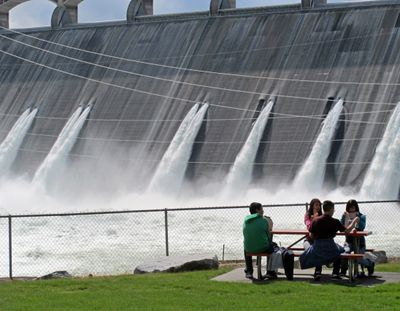Columbia River treaty outdated, federal regulators say

YAKIMA – A U.S.-Canada treaty that governs operations of the fourth-largest river in North America – affecting everything from power prices and water supplies to grain shipments and recreation in the Pacific Northwest – should be renegotiated to make the system more flexible amid climate change and to aid threatened and endangered species that weren’t considered when the treaty was created decades ago, federal regulators recommended in a draft document released to the Associated Press.
However, the document also says efforts to improve the ecosystem should not impair often competing efforts to ensure long-enjoyed low power prices in the region, which are made possible by 11 U.S. hydropower dams on the Columbia River and its tributaries.
Bill Dobbins, general manager of the Douglas County Public Utility District, which operates Wells Dam in Washington state, said the proposal to increase river flows in the spring, while it would help young salmon migrating to the ocean, would lead to less power production from the dams. Generators are already operating at capacity then, wind farms are producing power that competes for space on the grid, and the water would end up being spilled over the dams, rather than held in reserve for fall and winter.
He added it remained unclear what adding the term “ecosystem function” to the treaty would mean for dam operations, and how the proposals would be funded.
Paul Lumley, Columbia River Inter-Tribal Fish Commission executive director, praised the proposal to elevate ecological concerns to the same level as hydropower and flood control, saying it would make the treaty a model of international water management.
“Diminished water quality and quantity issues will frustrate the Columbia Basin’s ongoing salmon restoration efforts, and the region will be unprepared to address climate change,” he said in a statement.
Rep. Doc Hastings, R-Wash., said he met with members of the U.S. Entity on Friday and told them his concerns about the ecosystem issue.
“The U.S. Entity’s latest draft recommendation continues to raise contentious ecosystem concerns that only serve to distract from the essential task of working with Canada on the core issues under the treaty – the need to rebalance power benefits and to address long-term flood control needs,” he said in a statement.
Whether the document will unite those varied interests remains to be seen.
Originating high in the Rocky Mountains in British Columbia, the Columbia River flows 1,240 miles through Canada and the United States to its mouth in the Pacific Ocean. Its drainage area crosses both countries and touches seven U.S. states, and its average annual runoff dwarfs the Colorado and Missouri rivers.
The runoff was deadly on Memorial Day 1948: Spring runoff from a melting heavy snowpack pushed the river over its banks far downstream in Oregon, killing more than 30 people and destroying the community of Vanport. Economic losses exceeded $100 million.
The disaster started negotiations between the U.S. and Canada for better management of the river’s dams and reservoirs, both for flood control and hydropower generation. The ensuing treaty, signed in 1964, has no expiration date, but either country may cancel it or suggest changes beginning in 2024 with 10 years’ notice.
The U.S. Army Corps of Engineers and the Bonneville Power Administration are leading the review of the treaty in consultation with other federal agencies, four Northwest states and more than a dozen tribes. U.S. regulators will send their final recommendation in December to the State Department, where the ultimate decision on whether to renegotiate rests.
“The treaty has been a model of international water management,” said Steve Oliver of the Bonneville Power Administration, who is coordinating the effort for the U.S. Entity. “And we feel like it is appropriate to review it at this time.”
Under the treaty, Canada stores water behind three major dams for flood control and to maximize hydropower generation. In exchange, the U.S. agreed to pay Canada $64 million for flood control for the life of the treaty – far less than the estimated damages that would have occurred with additional flooding – and to send electricity generated at downstream U.S. hydropower dams to Canada.
At the time the treaty was signed, federal protections for endangered species didn’t exist; since then, 13 Pacific fish species have been listed for protection. In addition, tribal rights were not enforced, and climate change wasn’t an issue.